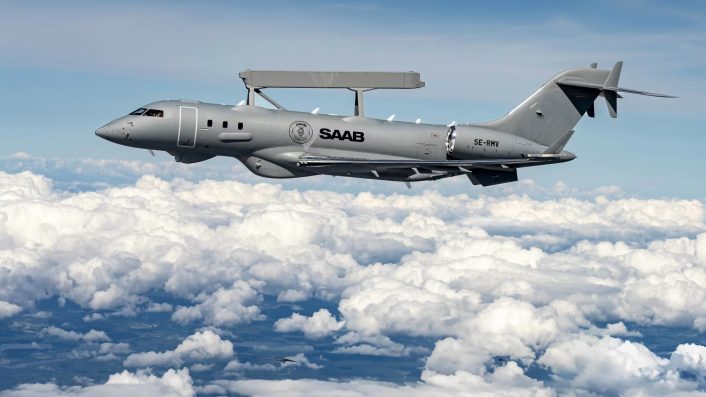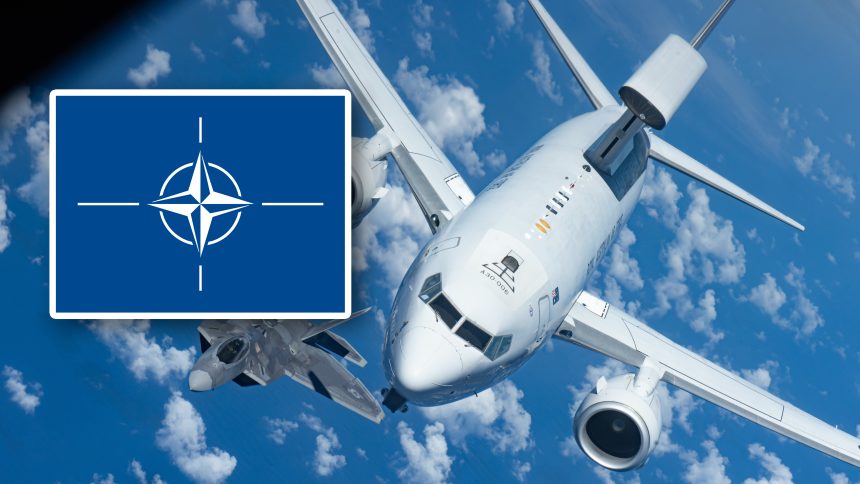After selecting the Boeing 737-based E-7 Wedgetail in 2023 to replace the E-3 Sentry, the group of nations leading the procurement of NATO’s next airborne early warning aircraft have now reversed course.
The Netherlands Ministry of Defence has announced, on behalf of the wider initial Alliance Future Surveillance and Control (iAFSC) Support Partnership Committee nations, that alternatives will now be sought to replace the ageing NATO fleet of E-3A Sentry airborne warning and control system (AWACS) aircraft by 2035. The Support Partnership Committee was initially composed of Belgium, Germany, Luxembourg, the Netherlands, Norway, Romania and the United States, though the United States withdrew its participation in July.
NATO’s choice of the E-7 platform was heavily swayed by the strategic and financial benefits of operating a common type alongside the U.S. Air Force and, to a lesser degree, the UK Royal Air Force. With U.S. plans shifting away from the E-7 – despite Congress-mandated funding still flowing – those benefits have become increasingly uncertain. The Royal Air Force, at present, plans to operate only three E-7 aircraft.
Though the UK order was placed in advance of the U.S. and NATO deciding on the E-7, commonality with these major partners was anticipated to help sustain the aircraft in the long term. The UK’s acquisition has been plagued by delays, cost overruns, and controversy, and this is only likely to get worse following NATO’s decision.
The U.S. will still procure at least a small number of E-7s – the contract for the first two rapid prototypes having been awarded to STS Aviation in Birmingham, UK – however any widespread adoption of the aircraft would seemingly come against the will of the current Department of Defense (DoD) administration. Proposing the E-7’s cancellation in its 2026 budget proposal, the DoD instead wished to invest in space-based early warning technology with the E-2D Hawkeye as a potential lower-cost stopgap solution.
“To set the record here, this [#E7 AEW&C cancellation] was an OSD [Office of Secretary of Defense] proposal. The Air Force had a full up plan to acquire the E-7 #Wedgetail..” pic.twitter.com/7KodCnhfIt
— AirPower 2.0 (MIL_STD) (@AirPowerNEW1) November 13, 2025
Those in control of the budgets, however, have other ideas. Politicians in the U.S. Congress have repeatedly fought to have funding for the E-7 reinstated, and in recent days won a significant victory with E-7 funding included in a bill aimed at ending the federal government shutdown.
From an initial fleet of 18 E-3 Sentry airframes, NATO currently operates 14 AWACS aircraft. Following rapid retirements of aircraft, the U.S. Air Force’s inventory sits at a similar number. NATO intends to see its E-3s operate out to 2035, with press releases referring mostly to noise pollution as a source of issues with the aircraft. The U.S. Air Force, meanwhile, has repeatedly drawn attention to the increasingly difficult maintenance requirements of the Boeing 707-based aircraft. We reported in a previous article that the type’s mission readiness rate in 2024 stood at only 55.7%, and maintainers working on the aircraft are required to hold proficiency in as many as three to four times more specialist tasks compared to those working on other types.
It should be noted that while the U.S. Air Force fleet is expected to see long term overseas deployments across the globe, NATO’s fleet is able to place its prime focus on European airspace. This allows the NATO E-3s to operate mostly from their home base or relatively nearby, with all logistical support readily available, and perform fewer flight hours each year. In September, Pratt & Whitney received a contract to provide sustainment services for the NATO E-3 fleet’s TF33 turbofan engines.
Puts all these orbits in a different perspective.
🇪🇺🇱🇺 NATO01 is E-3A Sentry AWACS LX-N90445 #4D03C3 https://t.co/pRLLoRZjMM pic.twitter.com/gUe2HsY9Lr
— Evergreen Intel (@vcdgf555) September 19, 2025
Mark Rutte’s Press Conference
Though seemingly timed alongside the announcement to not procure the E-7, a press conference with NATO Secretary General Mark Rutte on Nov. 13 in front of a NATO E-3 at their Geilenkirchen Air Base home oddly saw no mention of the decision nor any talk of specific alternative plans.
Instead, the former Dutch Prime Minister, who has headed NATO since 2024, paid tribute to the personnel who served at the base as well as others in the area. He also reinforced the importance of the airborne early warning mission to NATO’s overall defence.
A pleasure to visit NATO’s Airborne Warning and Control Force – Thanks Maj General Korb for welcoming Minister-President @HendrikWuest & myself to the base in Geilenkirchen. Hosting @NATOAWACS the men and women here are doing a crucial job – as NATO’s eyes in the sky, you make… pic.twitter.com/2PbDSyyBA0
— Mark Rutte (@SecGenNATO) November 13, 2025
When asked by reporters about the replacement of the AWACS aircraft, Rutte said that “the planes need to be replaced, that’s clear, so that process is ongoing, and I will do everything to speed up that process.”
Erieye Alternative
The primary alternative to the E-7 mentioned by many is the Saab Erieye system. With Sweden now part of NATO, Erieye exists as both a European option and one that still comes from within the alliance. In the press release about the cancellation of the E-7 plans it was specifically mentioned that the “US withdrawal also demonstrates the importance of investing as much as possible in European industry.”
Erieye is a smaller system than the MESA array carried by the E-7 Wedgetail, but it still provides an active electronically scanned array (AESA) and, reportedly, 360 degrees of detection. According to Jane’s, each side of the radar offers 130 degrees of scanning and tracking, while the remaining 30 degrees fore and aft are detect-only with no tracking. This could be mitigated to some degree by flying circular ‘orbits’ like the current E-3, though the similarly configured E-7 is intended to fly racetrack patterns instead with long straight parallel lines to maximize the on-target duration of its larger side arrays.

France has chosen latest generation of the Erieye system integrated on a Bombardier Global business jet (in a combined product known as GlobalEye) to replace its E-3 Sentry fleet, and, as the home of Saab, the system is also used by the Swedish Air Force.
It is widely thought that the Erieye radar is unable to match the raw performance of the E-7’s MESA, however the lower cost and smaller footprint, allowing for smaller, cheaper aircraft and more of them, might outweigh the performance hit. When battling the E-7 for the Royal Air Force contract, Saab proposed an A330 Erieye system that would have seen the widebody airliner carry two radar arrays on its upper fuselage at the same time.
With a deadline of 2035 at the very latest, it seems unlikely that Airbus would be able to pull anything out of the bag on its own without a partnership with Saab for the Erieye system.









